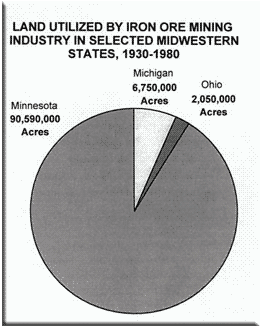Iron ore deposits were found in many areas of the United States, but mining was centered in western Pennsylvania and eastern Ohio during the post-Civil War period. Iron production and the emerging steel industry developed around Pittsburgh, which enjoyed the additional advantage of nearby coal fields.
 Phenomenal industrial growth in the 1870s and 1880s, seriously depleted many of the known iron ore deposits. Exploratory efforts were undertaken to locate new sources.
Significant discoveries were made in the Marquette Range in Michigan’s Upper Peninsula and in areas surrounding Birmingham, Alabama.
By far, the most significant new deposits to be located were those in northeastern Minnesota, in particular the Mesabi Range. Large deposits of high grade ore were discovered there in 1890; production was under way two years later and the area became the leading iron ore source in the world. This success occurred even without the proximity of coal fields; the availability of cheap railroad and barge traffic to distant production points rendered the mining effort highly profitable. Chicago, and later Cleveland, became major steel production sites.
Large holdings in the Mesabi were owned by John D. Rockefeller, who later sold out to ^Andrew Carnegie^. The mines continued to supply high grade ore for more than 50 years, but then turned to the production of lower grade taconite.
Phenomenal industrial growth in the 1870s and 1880s, seriously depleted many of the known iron ore deposits. Exploratory efforts were undertaken to locate new sources.
Significant discoveries were made in the Marquette Range in Michigan’s Upper Peninsula and in areas surrounding Birmingham, Alabama.
By far, the most significant new deposits to be located were those in northeastern Minnesota, in particular the Mesabi Range. Large deposits of high grade ore were discovered there in 1890; production was under way two years later and the area became the leading iron ore source in the world. This success occurred even without the proximity of coal fields; the availability of cheap railroad and barge traffic to distant production points rendered the mining effort highly profitable. Chicago, and later Cleveland, became major steel production sites.
Large holdings in the Mesabi were owned by John D. Rockefeller, who later sold out to ^Andrew Carnegie^. The mines continued to supply high grade ore for more than 50 years, but then turned to the production of lower grade taconite.